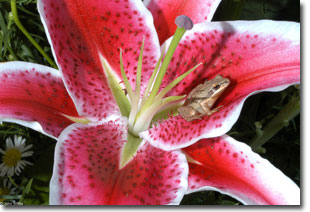Frogs and Toads
20 native and 1 introduced species in Maryland
 Frogs and toads are amphibians that do not typically have a tail as adults. The hind legs are longer than the front legs and are modified for jumping. The body is relatively short and the head is not separated from the body by a discernable neck. The larval or tadpole stage of most frogs and toads is entirely aquatic. Tadpoles possess a tail and do not have legs until late in development, just prior to metamorphosis to the adult form. Frog and toad tadpoles with legs can be distinguished from aquatic salamander larvae by the lack of a discernable neck, the presence of distinctly longer back limbs compared to the front limbs, and the absence of external gills, as are seen in salamander larvae.
Frogs and toads are amphibians that do not typically have a tail as adults. The hind legs are longer than the front legs and are modified for jumping. The body is relatively short and the head is not separated from the body by a discernable neck. The larval or tadpole stage of most frogs and toads is entirely aquatic. Tadpoles possess a tail and do not have legs until late in development, just prior to metamorphosis to the adult form. Frog and toad tadpoles with legs can be distinguished from aquatic salamander larvae by the lack of a discernable neck, the presence of distinctly longer back limbs compared to the front limbs, and the absence of external gills, as are seen in salamander larvae.
Below is a list of the five families and the number of species in each family found in Maryland.
Frog Family | Number of Species
in Maryland |
| 8 |
| 9 |
| 2 |
| 1 |
| 1 |
True Toads (Family Bufonidae)
True toads have thick, dry, warty skin and have enlarged, warty glands in the shoulder region called parotoid glands. Unlike most frogs, true toads tend to produce short hops to escape danger rather than long leaps (Conant and Collins 1998).
There are only two species of true toads found in Maryland. They include the eastern American toad (Anaxyrus americanus americanus) and the Fowler’s toad (Anaxyrus fowleri).The two species can be distinguished from each other based on the number of warts in each pigmented spot on the dorsum, the presence or absence of conspicuously enlarged warts on the tibia, spotting on the chest, and the amount of separation between the cranial crest and the parotoid glands (Conant and Collins 1998).
Narrow-mouthed Toads (Family Microhylidae)
Spadefoot Toads (Family Pelobatidae)
True Frogs (Family Ranidae)
True frogs have long powerful hind legs with webbed feet. They have relatively stout waists and large broad mouths. The toes do not have discs or pads at the tips as in the treefrogs (Hylidae). All of the true frogs found in Maryland have smooth skin with no bumps or tubercles, and most have ridges that run along the sides of the back (dorsolateral ridges). All Maryland frogs in Family Ranidae are in the genus
Lithobates.
Many true frog tadpoles grow relatively large and may have an extended larval stage (up to three years). They can be found in many types of water bodies from ephemeral pools to permanent lakes, ponds and flowing streams.
Treefrogs (Family Hylidae)
Treefrogs are relatively small anurans. They have a slim waist, long thin limbs and most have toes that terminate in distinctly enlarged discs or pads (except for the eastern cricket frog in Maryland). Treefrogs are distinguished from one another by a number of characteristics including, the type of dorsal markings they possess, the length of the back limbs, the presence or absence of a light spot under the eye and along the upper lip, and the size of the toepads.
There are a total of nine species of treefrogs in three genera that can be found in Maryland. Members of the three genera (Hyla, Pseudacris, and Acris) can be distinguished from one another using fairly obvious physical characteristics.
- Hyla species are primarily arboreal and have greatly enlarged pads at the terminal ends of the digits to facilitate climbing. They lack dark longitudinal lines or “X” shaped markings on the dorsum.
- Pseudacris species are small and have longitudinal lines or an “X” shaped mark on the dorsum. Although the toe-pads are distinct, they are not as large as the toe-pads of Hyla species.
- The genus Acris is represented by one species in Maryland: the eastern cricket frog (Acris crepitans). This species is characterized by a longitudinal dark stripe on the rear surface of the thigh and toe-pads that are so small and indistinct that they are virtually absent.